Anti-tank weapons of the Soviet infantry (part 4)
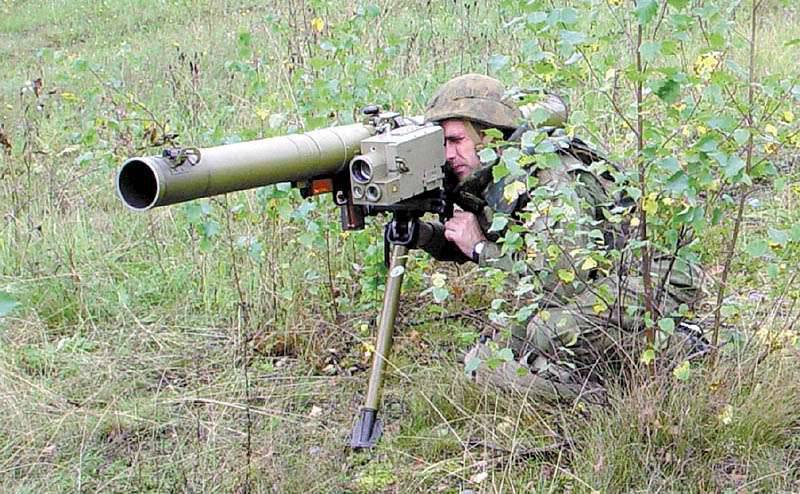
In the second half of the 60s, Soviet motorized rifles had at their disposal sufficiently effective anti-tank defense systems. The staff of each rifle department was a grenade launcher with RPG-2 or RPG-7. The anti-tank defense of the battalion was provided by the calculations of the SPG-9 easel grenade launchers and Malyutka portable anti-tank systems. However, individual infantrymen, left alone with the enemy armored vehicles, as in the years of the Great Patriotic War, could fight tanks the enemy only with hand anti-tank grenades. The RKG-3EM hand-held cumulative grenade normally could penetrate 220 mm of armor, but despite several degrees of protection, manually-shot cumulative ammunition was a huge danger for those who used it. According to the instructions, a fighter after throwing a grenade should immediately take refuge in a trench, or behind an obstacle that protects against fragments. But even so, an explosion of approximately 500 g of TNT at a distance of less than 10 m from the grenade launcher could lead to shell shock. In the course of real hostilities, in repelling the attacks of enemy armored vehicles, soldiers were the last to think about personal safety, and the use of powerful hand-held anti-tank grenades, which had to be used shortly, inevitably led to large losses among the personnel.
In order to increase the anti-tank capabilities of the infantry in the immediate vicinity of the leading edge in 1967, the specialists of TsKIB SOO and SSSBP "Basalt" began the development of a new individual anti-tank weapons, which was supposed to replace the manually thrown cumulative grenades RKG-3. In 1972, the RPG-18 “Fly” disposable anti-tank grenade was officially put into service.
Although the RPG-18 is actually a disposable grenade launcher, it was called a “rocket-propelled grenade” —that is, consumable ammunition. This is done to facilitate the process of recording and decommissioning, since it is much easier and faster to write off an anti-tank grenade used or lost during combat operations or exercises than a rocket launcher.
A number of sources say that work on the RPG-18 began after the Soviet specialists turned out to be American disposable grenade launchers M72 LAW, captured in Southeast Asia. It is difficult to say how much this is true, but in the Soviet rocket grenade some technical solutions are used, which were previously used in the American M72 LAW.
Smooth-wall "trunk" "Flies" is a telescopic sliding structure of the outer and inner tubes. On the surface of the outer pipe printed detailed instructions for the application of the RPG-18. But this, of course, does not mean that practical skills are not needed for the effective use of a rocket grenade.
The outer tube made of fiberglass protects the shooter from the effects of powder gases during a shot. In the rear upper part of the inner tube, made of high-strength aluminum alloy, there are shock-release mechanism assembled in one case with a locking device and a primer-igniter grenades. The length of the RPG-18 in the stowed position is 705 mm, in the cocked battlefield - 1050 mm.

RPG-18 "Fly" in a combat position and a split layout showing the internal structure in the stowed position
Even before the departure of the 64-mm rocket-propelled grenade from the barrel, complete combustion of the starting powder charge takes place in the barrel of the disposable trigger device. In contrast to the previously adopted jet anti-tank grenades PG-7 and PG-9, the cumulative RPG-18 grenade flies further by inertia, without acceleration by a sustained jet engine. The initial speed of the cumulative grenade - 115 m / s. In flight, a pomegranate is stabilized by four feather stabilizers that open up after departure from the barrel. To bring the rotation to grenade at a speed of 10-12 rev / s, the stabilizer blades have a slight slope. Rotation of the grenade is necessary to eliminate errors made in the manufacturing process and to increase the accuracy of shooting.
Sights include a spring-loaded front sight and diopter. The front sight is a transparent glass with 50, 100, 150 and 200 meters marked. At the level of the top of the aiming mark, corresponding to the range of 150 m, horizontal strokes are applied on both sides, which can be used to determine the distance to the tank. The effective firing range of the Fly is no more than 150 meters, but this is about 7-8 times as large as the maximum range of a hand-made cumulative Grenade RCG-3. Although the 64-mm RPG-18 grenade contains less explosive charge, the thickness of the homogenous armor punched is 300 mm, the Fly has surpassed the hand-held anti-tank grenade. This is due to the fact that the developers used a more powerful explosive - “okfol” (phlegmatized octogen) with a mass of 312 g and carefully selected the lining material and the geometry of the cumulative funnel. Undermining the warhead when hitting the target is made by an instantaneous piezoelectric fuse. In the event of a miss or failure of the main fuse, the grenade is undermined by the self-killer. The disadvantage of the RPG-18 can be considered that the rocket grenade cannot be returned to its original safe state after being transferred to the combat position. Not used for the intended purpose, the cocked jet grenades must be fired towards the enemy or blown up at a safe distance.
Although the RPG-18 weighing about 2,6 kg is about twice as heavy as the RCG-3, the reactive grenade has many times higher efficiency. In the hands of an experienced fighter, this weapon in 70-80-ies posed a serious danger to all types of armored vehicles. At a distance of 150 m, in the absence of a side wind, more than half of grenades are placed in a circle with a diameter of 1,5 m. The greatest probability of hitting tanks is when shooting at a side from a distance of no more than 100 m. When firing at moving objects, it is very important to correctly determine the optimal distance for opening fire and choose anticipation. Although the RPG-18 grenade does not have an active part on the flight path, a powerful jet of the shot may cause a dust or snow cloud to form, which is unmasked by the shooter. As in the firing of other anti-tank grenade launchers, when firing an RPG-18 behind the shooter, a dangerous zone is formed, in which there should be no other military personnel, obstacles and flammable objects.
Comparing the RPG-18 with the American one-time 66-mm M72 LAW grenade launcher, it can be noted that the Soviet model with a smaller caliber on the 150 g is heavier. With a higher initial speed - 140 m / s, the sighting range of the M72 LAW is the same - 200 m. The length of the American grenade launcher is 880 mm, folded -670 mm, which is less than that of the Fly. The armor penetration of the cumulative M72 LAW grenade containing 300 g Octola, according to US data, is 350 mm. Thus, it can be stated that with a slightly smaller overall dimensions, the American model practically does not differ in combat characteristics from the Soviet one.
Like the Fly, the one-time M72 LAW grenade launcher can no longer be considered an effective means of fighting modern tanks, and therefore is used mainly to destroy light field fortifications and against manpower.
In Soviet times, the RPG-18 was produced in huge editions. In the motorized rifle squad, which is in defense, a rocket-propelled grenade could be issued to every fighter. In addition to the Soviet Army, rocket-propelled grenades “Mukha” were delivered to the Allies under the Warsaw Pact and to a number of friendly countries of the USSR. The licensed production of the RPG-18 was also conducted in the GDR. Although the RPN-18 in 80-s did not provide penetration of the frontal armor of the newest Western tanks, the production of the Fly was going on until the 1993 of the year. In total, approximately 1,5 million RPG-18 units were produced.
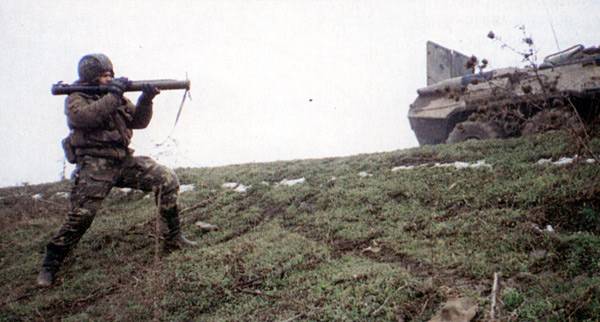
Soviet-made rocket grenades spread around the world and were actively used in many regional conflicts. However, most often they were used not for armored vehicles, but for manpower and for the destruction of light field fortifications. Based on service and combat performance, the RPG-18 can no longer be considered a modern anti-tank weapon, and although the “Fly” is still formally in service with the Russian Army, this rocket grenade in units of constant combat readiness has been replaced by more advanced models.
Already in the middle of 70's, it became clear that the RPG-18 was not able to penetrate the multi-layered frontal armor of promising West German, British and American tanks. Yes, and the widespread American M48 and M60 after installing additional screens and dynamic armor dramatically added to the security. In this regard, simultaneously with the saturation of troops with RPG-18 jet grenades, the development of a more powerful anti-tank infantry ammunition was underway. In 1980, the RPM-22 "Netto" anti-tank grenade entered the Soviet Army. In fact, it was the development version of the RPG-18 with increased caliber to 73-mm. A larger and heavier cumulative grenade was loaded with 340 g of explosives, which, in turn, increased the armor penetration. When hit at a right angle, the cumulative warhead could penetrate 400 mm in homogeneous armor, and at an angle 60 ° from the normal - 200 mm. However, it is wrong to consider the RPN-22 simply increased in size. Designers TsKIB SOO creatively reworked the design of a disposable rocket grenade, significantly increasing the characteristics of the new product. In the RPG-18, instead of the outer pipe, a retractable nozzle is used, which increases the length of the starting device by only 22 mm, in the RPG-100, after expanding the pipe, the length increases by 18 mm. Instead of the VP-345 fuse, a more reliable VP-18 is used with a cocking on 22 meters from the muzzle and self-destruction through 15-5 seconds after the shot.
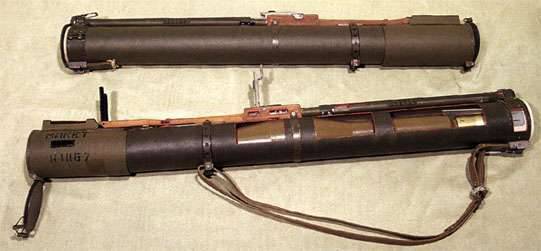
The development of a new powder charge formulation with an increased burning rate made it possible to reduce the duration of engine operation. This in turn increased the initial velocity of the projectile to 130 m / s while simultaneously shortening the barrel length. In turn, the direct shot range reached 160 m, and the aimed range of fire increased to 250 meters. The modified trigger mechanism has the ability to re-cocking in the event of a misfire. The length of the RPG-22 in the combat position was reduced to 850 mm, which made the treatment more convenient. At the same time, the mass of RPG-22 has become the most in 100.
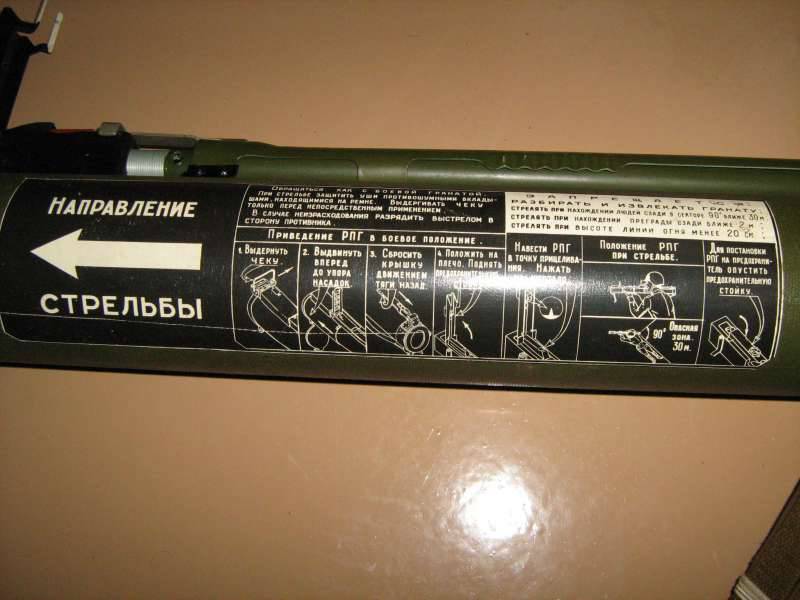
On the outer plastic pipe RPG-22 also has detailed instructions for use. As in the case of the RPG-18, after bringing the RPG-22 into a combat position, unspent grenades must be fired towards the enemy or blown up in a safe place.
The release of the RPG-22 in our country lasted until the 1993 year. In the middle of 80's, the licensed production of the RPG-22 "Netto" was developed in Bulgaria at the Arsenal plant in Kazanlak. Subsequently, Bulgaria offered these anti-tank ammunition in the global arms market.
RPG-22 rocket grenades were actively used in hostilities in the post-Soviet space. They have proven to be an effective and reliable means of defeating lightly armored vehicles and firing points. At the same time, when shooting at modern main battle tanks, the RPG-22 demonstrated that it is capable of striking tanks only at the side, at the stern, or from above, when firing from the upper floors or roofs of buildings. During the first Chechen campaign, there were cases when the T-72 and T-80 tanks withstood 8-10 RPG-18 and RPG-22 hits. According to reviews of military personnel who participated in the hostilities, the RPG-22 is a more effective weapon when firing at enemy manpower than the RPG-18. Rocket grenades showed themselves well in street fighting, for example, they could hit the militants who had taken refuge behind the walls of urban buildings.
In 1985, the RPG-26 Aglene anti-tank grenade entered service. When developing this munition, the specialists of NPO Bazalt took into account the operating experience in the troops of the RPG-18 and RPG-22. In particular, in addition to increasing the armor penetration, the transfer of the grenade to the combat position was facilitated, the possibility of transferring from the combat position to the traveling one became easier, the length of the ammunition in the combat position was reduced. The time taken to transfer a rocket grenade from a marching to a combat position was reduced by two times.
Although the caliber RPG-26 remained the same as in the RPG-22 - 73-mm, thanks to the use of a more sophisticated jet engine, the initial speed of the grenade was 145 m / s. In this regard, the accuracy of fire increased, and the direct shot range increased to 170. Improving the design of the cumulative warhead while maintaining the same caliber allowed us to increase the armor penetration to 440 mm. The weight of the RPG-26 is 2,9 kg - a total of 200 g more compared to the RPG-22.
The new infantry anti-tank ammunition has become easier structurally and much more technologically advanced in production. The starting device RPG-26 is a monoblock fiberglass pipe impregnated with epoxy resin. From the ends, the tube is closed with rubber plugs discharged when fired. To transfer the RPG-26 to the combat position, a safety check is retrieved. After casting sights in the combat position, the firing mechanism is cocked. The shot is made by pressing the trigger. If necessary, remove the trigger from the platoon, you should lower the rear sight in the horizontal position and fix it with a check.
Despite the fact that the Agleni RPG-26 rocket grenade can penetrate only the onboard armor of modern tanks, this ammunition is in service with the infantry and airborne units of the Russian army. With the help of RPG-26 you can hit lightly armored vehicles, destroy manpower and light field fortifications of the enemy.
In 80, the battle between armor and anti-tank weapons continued. In 1989, the Tavolga RPG-27 rocket grenade, which differed from the RPN-26 mainly in the 105-caliber tandem warhead, unified with the RPG-12NXXP rocket grenade for the reusable RPG-7 rocket launcher, entered service.
This ammunition is able to hit the normal 600 mm armor, covered with dynamic protection. The initial speed of the RPG-27 grenade is about 120 m / s. Direct shot range - 140 m. The transfer of the grenade launcher from the traveling position to the combat position and back is carried out in the same manner as that of the RPG-26.
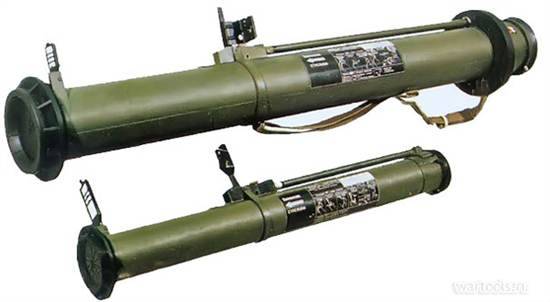
RPG-27 compared with RPG-26 has become longer on 365 mm. The mass of 105-mm anti-tank ammunition increased almost 3 times and is 8,3 kg. It is believed that the increase in the cost, mass and dimensions of a disposable rocket grenade, with a certain decrease in the range of a direct shot, is an acceptable price for the ability to fight modern tanks covered with multi-layer combined armor and dynamic protection. However, in the time that has passed since the RPG-27 appeared, the security of the Leopard-2, Challenger-2 and M1A2 SEP Abrams tanks has increased significantly. According to information published in open sources, armor in the frontal projections of these machines with high probability can resist when hit by RPG-27.
Simultaneously with the creation of disposable jet grenades of increased armor penetration, munitions for reusable grenade launchers were improved. As mentioned in the second part of the review, in an 1988 year, an RPG-7 grenade launcher was shot with a tandem warhead PG-7BP. This munition was developed in the framework of the OCR “Summary” after a sharp decline in the effectiveness of the use of anti-tank grenade launchers against Israeli tanks equipped with Blazer dynamic defenses was revealed during the fighting in Lebanon in 1982. The combat part of the PG-7BP grenade, consisting of two cumulative combat units - the front (precharge) caliber 64 mm and the main caliber 105 mm, provides penetration of 600 mm armor after overcoming the dynamic protection. With an increase in the mass of the PG-7BP rocket launcher to 4,5 kg, the range of the aimed shot was only 200 m. It is quite natural that the leadership of the Ministry of Defense wanted to have powerful anti-tank weapons with a greater effective firing range, while maintaining the relatively low cost typical of reusable grenade launchers and unmanaged jet grenades. In connection with this, shortly before the collapse of the USSR, the NPO Bazalt created the reusable Vampire RPG-29 grenade launcher. This weapon with a loaded barrel is conceptually close to the VDVshnom RPG-16. For shooting from the RPG-29, a shot is used with a tandem warhead used earlier in PG-7BP.

The complete combustion of the pyroxylin powder charge ends before the grenade leaves the barrel. At the same time, grenade PG-29В accelerates to 255 m / s. The range of the aimed shot of the RPG-29 reaches 500 meters, which is two times higher than in the shooting of the PG-7BP tandem grenade from the RPG-7. After the powder charge burns out, stabilizers are released, which open up after leaving the bore. The absence of a jet engine operating in flight, makes it possible to simplify the design of a grenade launcher and ammunition, as well as reduce the impact of shot products on the calculation.
For a clearer visual observation of the flight of the grenade it has a tracer. In addition to the cumulative grenade for the RPG-29, a TBG-29В shot with a thermobaric warhead equipped with a charge of 1,8 kg was adopted. In its striking effect, TBG-29В is comparable to 122-mm artillery shells. This ammunition is ideal for hitting enemy personnel in trenches, bunkers, rooms up to 300 cubic meters. The radius of a continuous defeat of manpower in an open area is 8-10 m. In the case of a direct hit of the power of the charge, it is enough to break the 25 mm steel armor sheet. However, the shot on a modern tank thermobaric ammunition is unlikely to pass for him without a trace. In the case of a grenade detonation TBG-29В on frontal armor damage will receive sights, observation devices and tank armament.
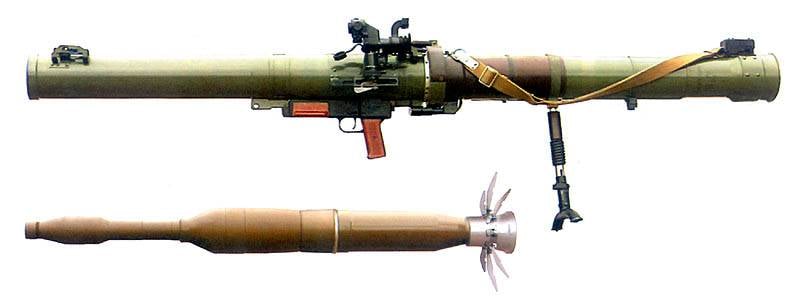
Smooth caliber barrel rocket launcher is made detachable for easy transportation. In the process of the shot, an electric igniter is used to ignite the reactive charge. Its operation is due to an electric pulse, which is generated by a trigger mechanism located in the grenade launcher itself. Similar shot production schemes are used in LNG-9 and RPG-16 grenade launchers. During the military trials, a coordinated calculation of three people per minute made four aimed shots.
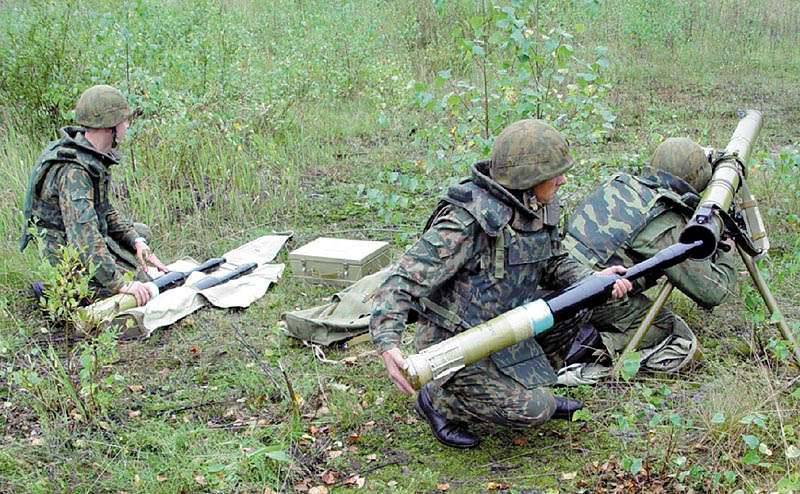
Loading grenade comes from the rear breech. The grenade launcher has an open mechanical sight, but the main scope of the PGO-29 (1P38) optical lens with the increase of the 2,7 crater is provided. For shooting in the dark at the RPG-29H modification, the 1PN51-2 night sight is used. For convenience of shooting from a prone position, there is a back bipod.
After completion of the tests, the RPG-29 in 1989 was adopted. However, the grenade launcher did not enter the troops. With a weight with an optical sight 12 kg and length in the combat position 1850 mm, the RPG-29 was too heavy for a platoon-level anti-tank weapon. At the level of the company and the battalion, he lost the available ATGM. The heavy and bulky Vampire did not fit into the concept of using anti-tank weapons in a global war, with massive use of tanks, artillery and ATGM. In addition, the saturation of the Soviet motorized rifle units with the most diverse types of anti-tank weapons was already high.
Despite this, the RPG-29 is in demand from foreign buyers. In 1993, at the IDEX-93 weapons exhibition in Abu Dhabi, the grenade launcher was first demonstrated to the general public. Official deliveries of the RPG-29 were conducted in Syria, Mexico and Kazakhstan. After the successful use of "Vampires" in 2006 in Lebanon against Israeli armored vehicles, a small number of upgraded RPG-29 purchased the Russian Ministry of Defense.
In addition to some changes designed to improve ease of handling and reliability, a combined optical-electronic sight 2Ц35 was installed on the grenade launcher. This electronic device is mounted instead of a standard optical sight. The effectiveness of the RPG-29 significantly increased when simultaneously with the use of a new sight weapon is mounted on a tripod machine.
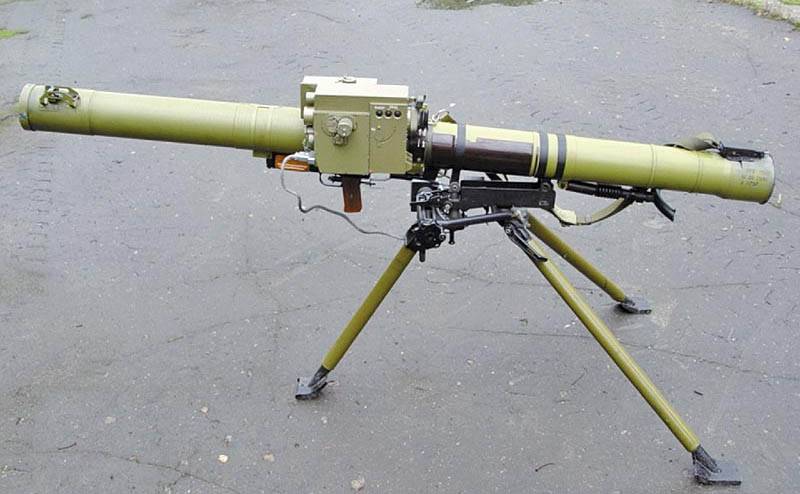
The built-in laser range finder can measure the distance to the target with high accuracy during the day and at night and calculate the necessary corrections when firing at a distance of up to 1000 meters. In this case, the RPG-29 occupies the niche of a light recoilless gun.
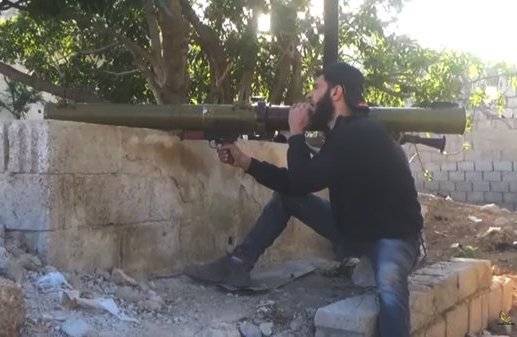
It so happened that a significant part of the “Vampires”, staged with Syria, fell into the hands of all sorts of terrorist groups. This weapon has created many problems not only for Israeli tank crews, but also for the military forces of the Syrian and Iraqi forces. In the period from 2014 to 2016, video footage of burning and exploding Syrian tanks filled the Internet. Militants armed with captured RPG-29 flashed regularly in frames. However, to date, the emergence of new videos with the participation of "Vampire" has almost stopped. The fact is that the stocks of the rocket-propelled grenades captured from the government forces dried up, and the experienced grenade throwers were mostly knocked out.
Although the Vampire RPG-29 was not produced in significant amounts during the Soviet era, it became the last anti-tank grenade launcher formally adopted by the USSR. But this does not mean that after the collapse of the Soviet Union, work on promising reusable grenade launchers and rocket-propelled grenades in our country stopped. You can read more about Russian rocket launchers here: Russian anti-tank grenade launchers and disposable rocket grenades.
Based on:
http://www.rusmilitary.com/html/missles_launchers.htm
http://modernfirearms.net/ru/granatomety/rossija-granatomety/rpg-22/
http://bazalt.ru/close_in_weapon_systems/
http://militaryrussia.ru/blog/topic-439.html
http://gunrf.ru/rg_granatomet_rps-7_PG-7VR_ru.html
http://warbook.info/item/rpg-29-vampir


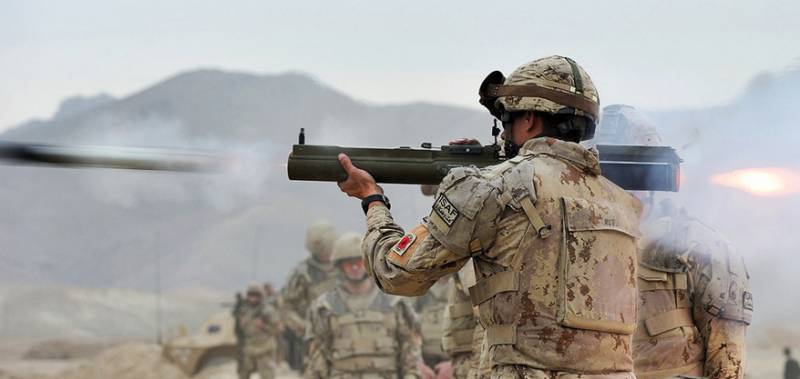
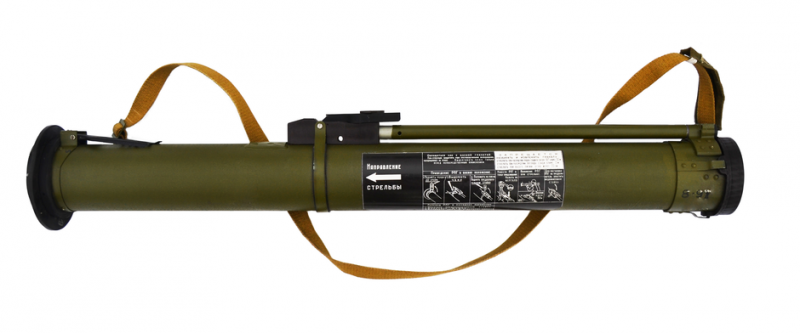
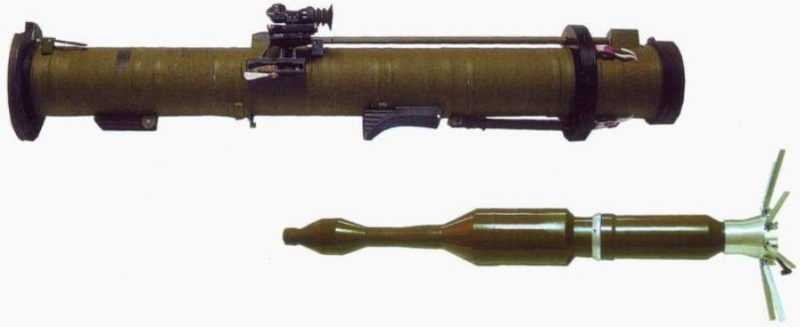
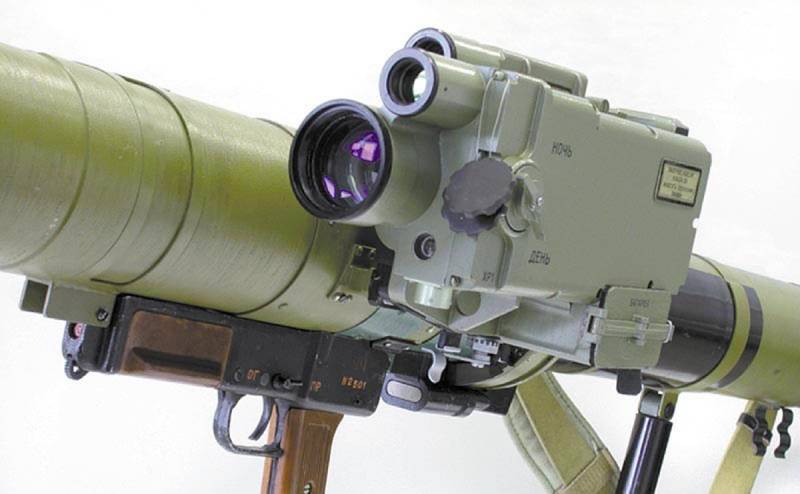
Information